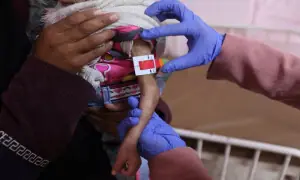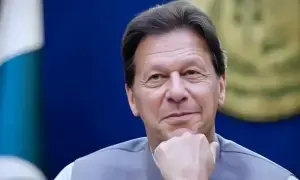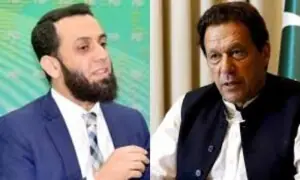Israel bombards southern Gaza as humanitarian crisis reaches ‘breaking point’
Israeli war planes and artillery bombarded Khan Younis in the south of the Gaza Strip on Saturday, hitting mosques and homes and close to a hospital, after the collapse of a truce in the nearly two-month-old war between Israel and Hamas.
The Gaza health ministry said at least 193 Palestinians had been killed and 650 wounded since the truce ended on Friday morning - adding to the more than 15,000 Palestinians dead since the start of the war.
The head of the International Red Cross said the renewed fighting was intense.
“It’s a new layer of disruption coming on top of massive, unparalleled destruction of critical infrastructure, of civilian houses and neighbourhoods,” Robert Mardini told Reuters in Dubai.
With conditions inside the Hamas-ruled enclave reaching “breaking point”, in Mardini’s words, the first aid trucks since the end of the truce entered Gaza through the Egyptian side of the Rafah crossing on Saturday, Egyptian security and Red Crescent sources told Reuters.
The warring sides blamed each other for the collapse of the seven-day truce, during which Hamas had released hostages in exchange for Palestinian prisoners held in Israeli jails.
The southern part of Gaza was taking a pounding on Saturday. Residents said houses and open areas had been hit and three mosques destroyed in Khan Younis. Columns of smoke rose into the sky.
In Deir Al-Balah city in central Gaza, nine Palestinians, including children, were killed in an air strike, health officials said.
Displaced Gazans have been sheltering in Khan Younis and Rafah because of fighting in the north of the densely populated enclave, but residents said they feared Israeli troops were preparing to move on the south.
“This is the same tactic they used before entering Gaza and the north,” said Yamen, who gave only his first name.
Yamen fled to Deir Al-Balah from the north after Israel destroyed several districts there.
“Where to after Deir Al-Balah, after Khan Younis? I don’t know where I would take my wife and six children,” he said.
On Saturday morning, Israeli war planes attacked areas close to the Khan Younis Nasser Hospital six times, according to medics and witnesses.
The hospital is filled with thousands of displaced and hundreds of wounded, including many of those who had been evacuated from north Gaza hospitals.
Renewed fighting in Gaza stretched into a second day on Saturday after talks to extend a week-old truce with Hamas collapsed and mediators said Israeli bombardments were complicating attempts to again pause hostilities.
Eastern areas of Khan Younis in southern Gaza came under intense bombardment as the truce deadline lapsed shortly after dawn on Friday, with columns of smoke rising into the sky, Reuters journalists in the city said.
Residents took to the road with belongings heaped up in carts, searching for shelter further west.
Israel said its ground, air and naval forces struck more than 200 “terror targets” in Gaza. By Friday evening, health officials in the coastal strip said Israeli strikes had killed 184 people, wounded at least 589 others and hit more than 20 houses.
The warring sides blamed the other for the truce collapse by rejecting terms to extend the daily release of hostages held by militants in exchange for Palestinians held in Israeli jails.
The United Nations said the fighting would worsen an extreme humanitarian emergency. “Hell on Earth has returned to Gaza,” said Jens Laerke, spokesperson for the U.N. humanitarian office in Geneva.
“Today, in a matter of hours, scores were reportedly killed and injured. Families were told to evacuate, again. Hopes were dashed,” said U.N. aid chief Martin Griffiths, adding that children, women and men of Gaza had “nowhere safe to go and very little to survive on.”
A pause that started on Nov. 24 had been extended twice and Israel had said it could continue as long as Hamas released 10 hostages each day. But after seven days during which women, children and foreign hostages were freed, mediators failed to find a formula to release more.
Israel accused Hamas of refusing to release all the women it held. A Palestinian official said the breakdown occurred over female Israeli soldiers.
Israel has sworn to annihilate Hamas after an Oct. 7 rampage in which it says the militant group killed 1,200 people and took 240 hostage.
Israeli assaults since have laid waste much of Gaza, ruled by Hamas since 2007. Palestinian health authorities deemed reliable by the United Nations say over 15,000 Gazans have been killed and thousands are missing.
QATAR SAYS NEGOTIATIONS CONTINUING
Qatar, which has played a central mediating role, said negotiations were still going on with Israelis and Palestinians to restore the truce, but Israel’s renewed bombardment of Gaza had complicated matters.
An Israeli official in Washington said it was a “very high priority” to get as many hostages released as possible.
“And for that, under agreed terms, Israel is willing to give additional pauses,” the official said, while adding: “We can negotiate while we still fight.”
In the north of Gaza, previously the main war zone, huge plumes of smoke rose above the ruins. Gunfire and explosions rang out above the sound of barking dogs.
Residents and officials from Hamas said its fighters armed with rocket-propelled grenades battled Israeli troops and tanks in Gaza City’s Sheikh Radwan neighbourhood in the north.
Sirens blared across southern Israel as militants fired rockets from the coastal enclave into towns. Hamas said it had targeted Tel Aviv, but there were no reports of casualties or damage there.
Casualties were reported in southern Lebanon, another flashpoint of conflict for Israel. A Lebanese official said Israeli shelling killed three people on Friday. The Iran-backed Lebanese group Hezbollah, a Hamas ally, said it had carried out several attacks on Israeli military positions at the border.
The Israeli army said its artillery struck sources of fire from Lebanon and air defences had intercepted two launches.
Reuters could not confirm the battlefield accounts.
U.S. AND HAMAS TRADE ACCUSATIONS
The United States blamed Hamas for the renewed fighting, saying it had failed to produce a new list of hostages to release.
U.S. Defense Secretary Lloyd Austin said Washington was working diplomatically to restore the truce.
“We’re going to continue to work with Israel and Egypt and Qatar on efforts to re-implement the pause,” he told a news conference in California, while blaming Hamas for failing to meet conditions on hostages and for an attack in Jerusalem.
Democratic U.S. Senator Mark Warner, who chairs the Senate Intelligence Committee, said Washington should be putting pressure on Israel, telling Reuters:
“We should be pushing Israel to realize this is not only a military conflict, but it is a conflict for hearts and minds of people in the world and people in United States.”
Hamas accused Washington of giving a green light for an Israeli “war of genocide and ethnic cleansing.”
“Today, it brazenly repeats the Zionist lies, which hold Hamas responsible for resuming the war and not extending the humanitarian truce,” it said in a statement.
The Palestinian Red Crescent said Israeli forces had stopped all deliveries of aid into Gaza through the Rafah border crossing with Egypt.
COGAT, the Israeli agency for civilian coordination with the Palestinians, said aid agreed under the truce had been stopped but, at Washington’s request, “dozens” of other trucks with water, food and medical supplies had reached the enclave.
The U.S. is working on a plan with Israel to minimize harm to civilians in any military operation in southern Gaza, a senior U.S. official said.
Despite the latest casualty reports, the Israeli official in Washington said Israel was working with the U.S. and the U.N. to reduce harm to civilians using a “deconfliction mechanism”.
“We learned lessons from our northern Gaza operations and we are implementing them,” he said.
Friday’s bombing was most intense in Khan Younis and Rafah in the south, however, medics and witnesses said. Hundreds of thousands of Gazans have been sheltering there because of fighting in the north.
Leaflets dropped on eastern areas of Khan Younis ordered residents of four towns to evacuate - not to other areas in Khan Younis as in the past, but further south to Rafah.
“You have been warned,” said the leaflets, written in Arabic.
Israel released a link to a map showing Gaza divided into hundreds of districts, which it said would be used in future to communicate which areas were safe.
In Rafah, residents carried several small children, streaked with blood and covered in dust, out of a house that had been struck. Mohammed Abu-Elneen, whose father owns the house, said it was sheltering people displaced from elsewhere.
For the latest news, follow us on Twitter @Aaj_Urdu. We are also on Facebook, Instagram and YouTube.






















Comments are closed on this story.